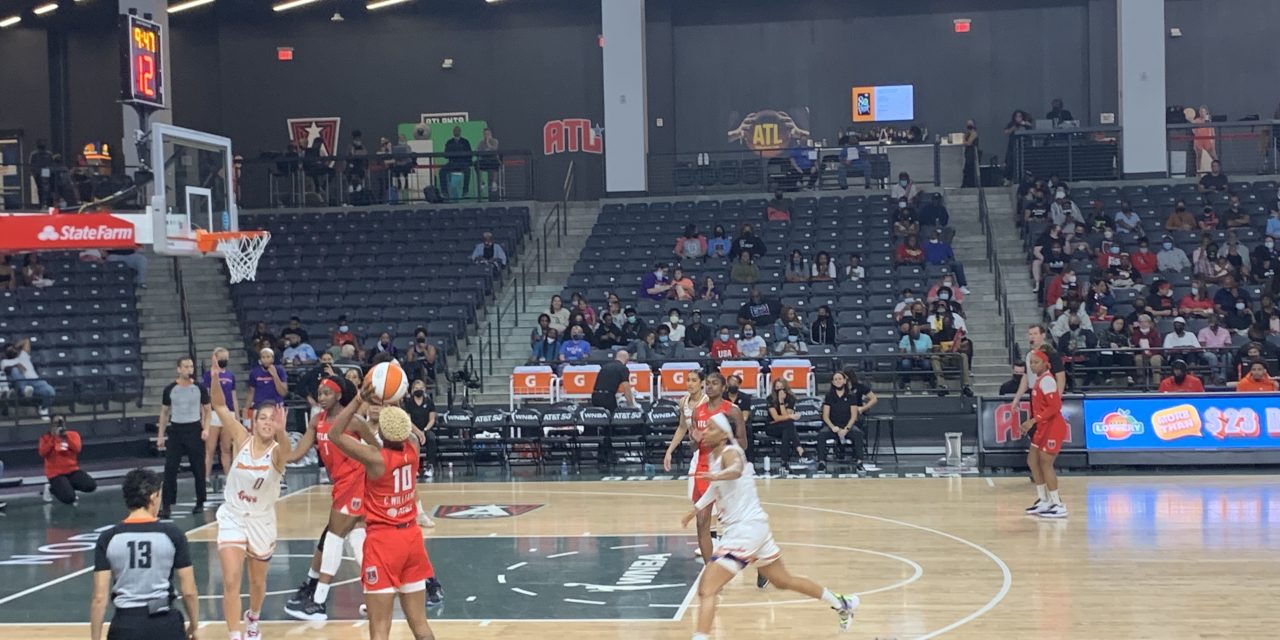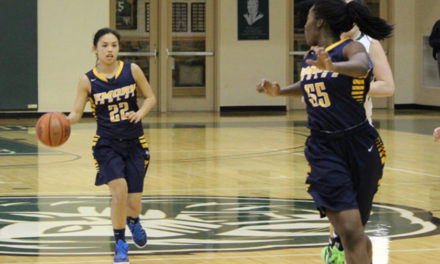To say it has been quite a year for the WNBA’s Atlanta Dream would be an understatement. With changes have come challenges, and it’s difficult to decide if the Dream is simply in transition or free fall.
Ownership change
Among the offseason hubbub this winter, a huge change happened down South: former co-owner and former Sen. Kelly Loeffler (R-Ga.) sold the Dream.
The sale came after years of conflict between ownership and players, boiling over when the league wore “VOTE WARNOCK” shirts during pregame warmups throughout the WNBA’s bubble 2020 season, the “Wubble.” As explained in the documentary “144” — which chronicled the Wubble season dedicated to Breonna Taylor, Say Her Name and the fight for Black lives — wearing the shirts was a decision to act in direct opposition to Loeffler’s campaign, standing in solidarity with the Black Lives Matter movement and voting accessibility: two themes of the season.
The Dream was even named the 2021 Sports Humanitarian Team of the Year at the Sports Humanitarian Awards presented by ESPN for their work.
For a league that has dedicated its 25 years to unprecedented social justice action and is comprised of over 75% Black women, Loeffler’s constant trail of anti-BLM and bigoted positions did not stand.
It came as no surprise that just a month after Loeffler lost her election to now-Sen. Raphael Warnock (D-Ga.), she decided to lose the Dream. The group of buyers included Northland chairman of real estate Larry Gottesdiener, Northland president Suzanne Abair and former Dream star Renee Montgomery.
Montgomery retired after sitting out the 2020 season and her involvement in the purchase makes her the first former player to become both an owner and executive of a WNBA franchise. Her ownership also illustrates a new wave of influence focused on the league.
The Dream’s roster, WNBA fans and Loeffler’s supporters embraced the transition of power, but the new management has endured a rocky start.
Revolving door of personnel turnover
During the offseason, the roster underwent some major adjustments. Many Dream fans rejoiced when guard Aari McDonald was drafted third overall in the 2021 WNBA Draft. McDonald skyrocketed to fame after leading the University of Arizona in an unprecedented March Madness run. The Dream also added forward Cheyenne Parker, power forward Tianna Hawkins and guard Odyssey Sims.
Their 2020 offseason was equally monumental, illustrated by the fact that their 2021 and 2019 rosters only share three players — center Elizabeth Williams, forward Monique Billings and guard Tiffany Hayes. But beyond the roster evolution, off-court changes have not been isolated to ownership.
In April, the Dream fired former President and General Manager (GM) Chris Sienko. Abair assumed the role of president, and Montgomery became vice president. The GM position, though, has remained vacant ever since. This begins a bad start to the year — an organization without a GM is inevitably in for an uphill battle.
Soon after, Head Coach Nicki Collen left the Dream to lead the ever-dominant Baylor University (Texas) women’s basketball program. Losing Collen was a huge blow to the organization; Collen won both Coach of the Year and helped lead the team to the Conference Finals in 2018.
Assistant Coach Mike Petersen was named interim head coach in May and made it almost three months before stepping down. Now, Assistant Coach Darius Taylor holds the interim head coach role.
On Sept. 8, the Dream announced another new hire — NFL Executive Morgan Shaw Parker will assume the role of president and chief operating officer. But with no GM, two presidents and three coaches over four months, chaos is an understatement.
Unfortunately for the Dream and their fans, the changes didn’t end there. In a shocking turn of events, the organization indefinitely suspended second-year standout guard and future of the franchise Chennedy Carter on July 5 for allegedly instigating a fight in the locker room with Dream star guard Courtney Williams after an on-court scuffle.
The argument prompted a subsequent tweetstorm. Teammates tweeted in support of C. Williams after she publicly defended herself, whereas Carter liked and tweeted in her own defense.
Rather than solely issuing an official statement, the new owners decided to weigh in.
Building a winning culture means holding ourselves accountable as a team. As we grow through situations, we will work towards helping our players in all aspects. No need to panic, it’s part of the grind ✍🏾#DoItForTheDream https://t.co/SFVNlijZ8G
— Renee Montgomery (@ReneeMontgomery) July 6, 2021
It’s apparent that there’s conflict among the organization and the roster. The few consistencies the Dream do have are personnel changes and losing.
A losing team
The most important part of the Dream’s journey is what’s happening on the court. As much as the payroll drama is interesting, the WNBA’s product often gets overlooked for a Twitter moment.
The Dream have only won seven games and lost 21 this season. They currently sit at 11th place in the league out of 12 teams, boasting a .250 win percentage.
From a simple sight-test, it seems that the Dream are playing the worst basketball in the WNBA. Since the Olympic break and Carter’s departure, the Dream only won a single game, deeming a playoff run impossible.
On top of the roster issues, the coaching decisions are confusing. McDonald is averaging under 15 minutes per game, and coupled with a playoff disqualifying record, the coaching staff is doing the team a disservice by not developing her on-court potential. The only way she is getting playing time is consolation after teammate injuries.
The team has lacked energy from the jump and offensively pays for it. They hold the league’s second-worst three point shooting percentage, the worst free throw shooting percentage and are below average in points per game.
Unfortunately, their defense is no better. They currently maintain the second-worst defensive rating in the league, and they especially struggle with defensive rebounding.
However, the Dream is not entirely lost. They just came off a significant win against the Dallas Wings and almost squashed Phoenix Mercury’s 10-game win streak, although they ended up losing by just one point after being ahead all game. It seems that leadership understands they’re lacking veteran insight and has aimed to remedy that by signing the WNBA’s fourth all-time leading scorer Candice Dupree, a forward, and hiring President Shaw Parker.
And even with all their personnel turnover, they have a foundational lethal weapon — shining star Courtney Williams. As their only all-star product of the year, she averages over 16 points a game and improves season after season.
C. Williams leads her teammates in almost every single statistic possible and is a born and raised Georgian. She is a force to be reckoned with and just as charming off the court.
The future of the franchise
When thinking about C. Williams and her impact on the team, it’s difficult not to worry about the future of the franchise. GM and coach-less, Carter in suspension and an unwillingness to take a chance on rookies makes you wonder if C. Williams should stay with the Dream.
William’s future is bright, but if the Dream don’t show that they’re willing to build around her, the team may be in impenetrable decline. Dream fans, myself included, can only hope that the offseason brings permanent hires, harmonious locker room restoration and for this promising new ownership to find their footing.
This team seems worth fighting for, and whether it be because of their joyful pre-game dance circles or Emory Healthcare sponsorship, I’m sure rooting for them.

Atlanta Dream star Courtney Williams shoots a three in Sep 8 home game against the Phoenix Mercury. (Gabriella Lewis/Podcast Editor)
Digital Operations & Podcast Editor | Gabriella Lewis (she/her, 23C) is from San Francisco, California, majoring in political science and women, gender and sexuality studies. She hosts the podcast Wheel Talk. Outside the Wheel, she is involved with residence life and voting rights at Emory. She also enjoys national parks, eating ramen and telling people she's from California.






